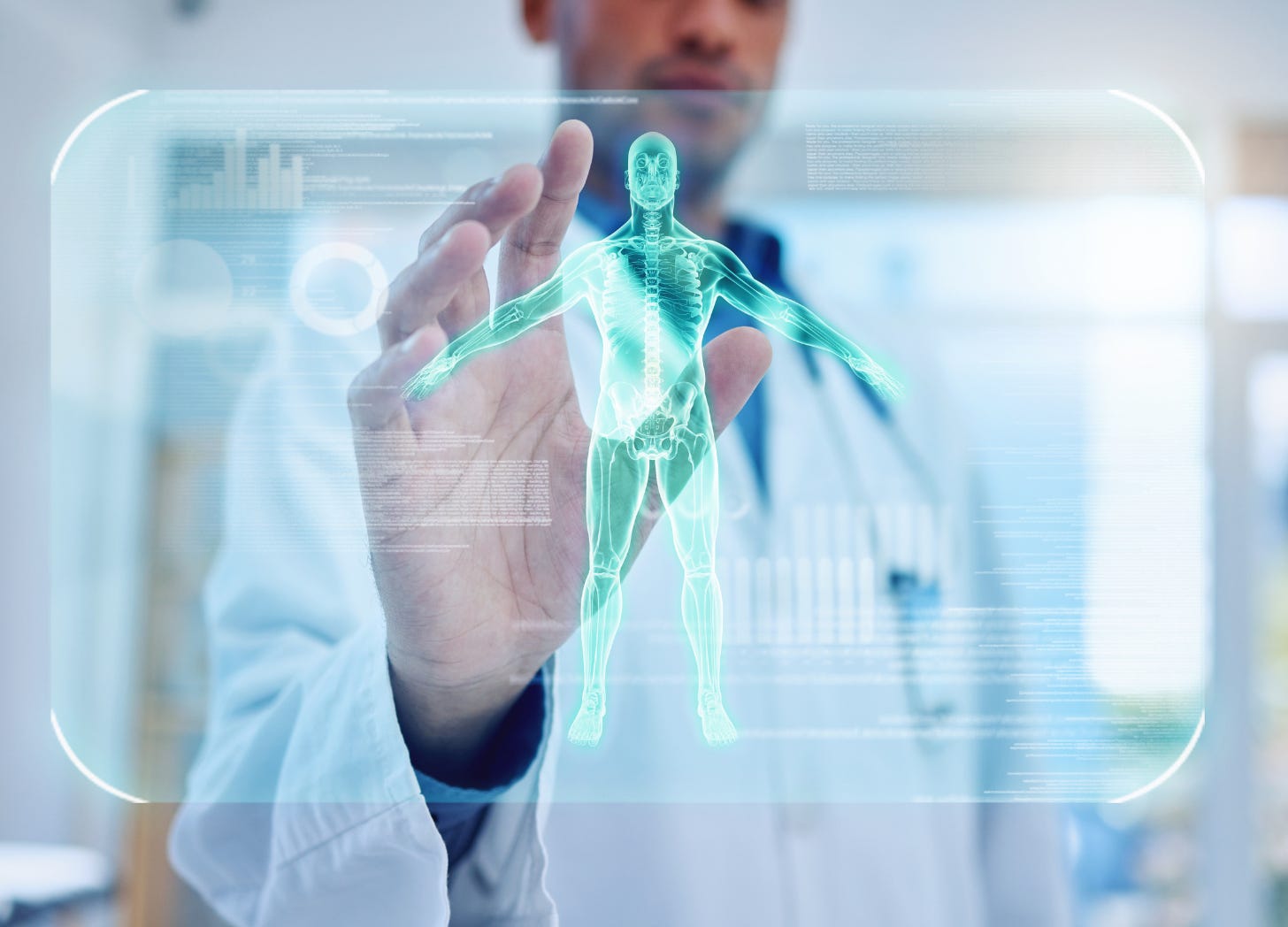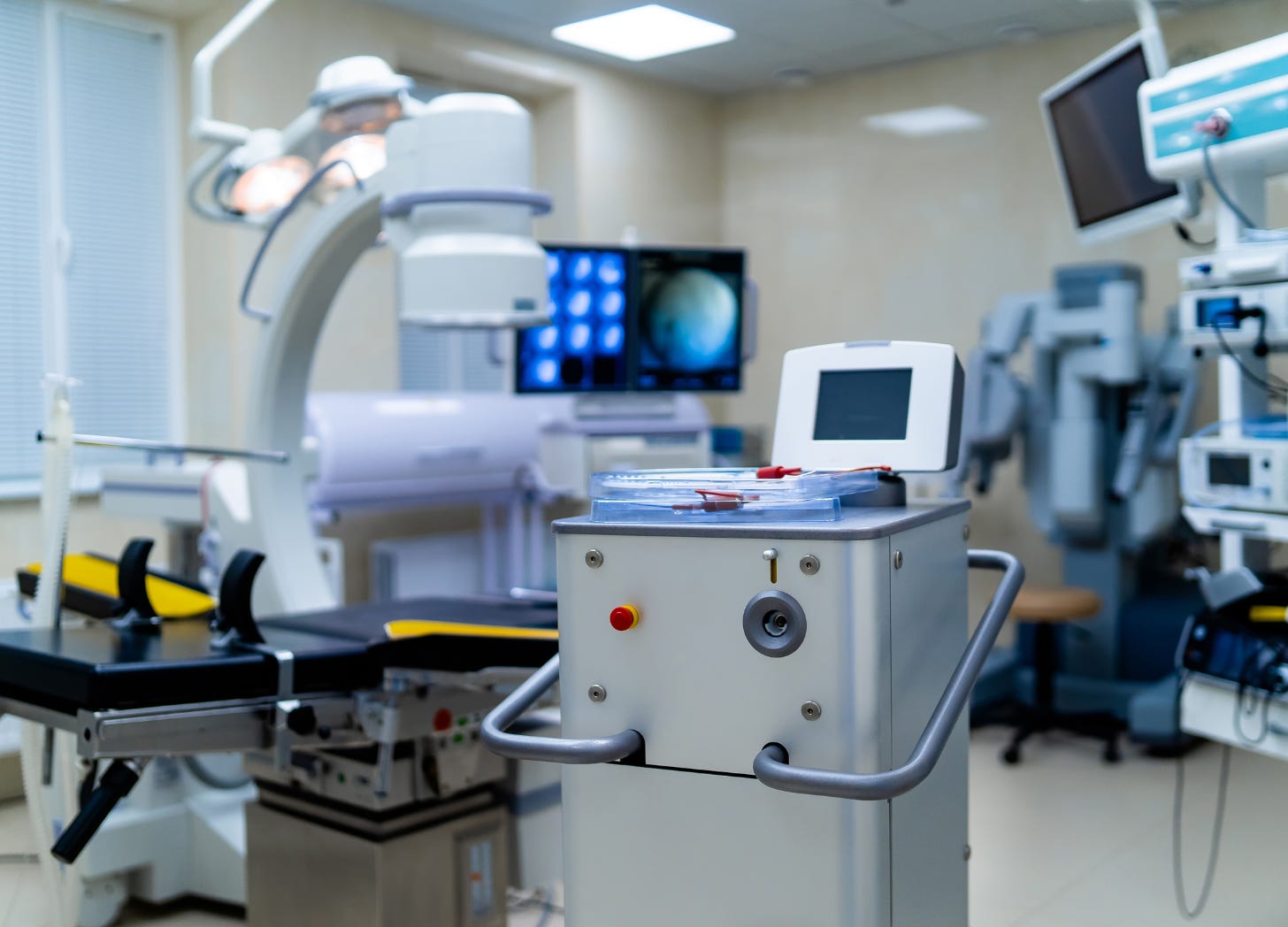I want you to imagine that the year is 2030, and you are a nurse entering a patients room that’s recovering from abdominal surgery…
As you step through the door, the lighting is soft and adjustable, automatically adapting to the time of day and the patient's sleep cycle.
You approach the bedside and glance at the large, wall-mounted display. The intelligent monitoring system greets you with a summary of the patient's condition. It highlights that the patient's vital signs have been stable throughout the night, with no significant abnormalities detected.
The AI-powered system has been continuously analyzing the patient's heart rhythm, respiration, blood pressure, and oxygen saturation, providing real-time insights and alerts if any concerning patterns emerge.
You remember when you had to manually check and record each vital sign, every few hours. Now, the intelligent monitoring system does this seamlessly, allowing you to focus more on patient care and less on documentation.
Next to the bed, you spot the patient's IV line, connected to an advanced infusion pump. The pump is controlled by an intelligent agent that precisely regulates the flow rate and dosage of medications, ensuring optimal pain management and preventing any potential medication errors. In the past, you had to double-check each medication and rate, but now you can trust the system to administer the correct dosage at the right time.
As you check the patient's surgical incision, you notice a small, non-invasive device attached to the skin nearby. The device uses advanced sensors to detect any signs of infection, such as changes in temperature or skin color, and alerts the medical team if there's a potential complication. This early warning system has dramatically reduced the incidence of post-operative infections in your hospital.
You gently reposition the patient to prevent pressure ulcers, and as you do so, the smart bed automatically adjusts to distribute the pressure evenly. The bed also monitors the patient's movement and can alert you if the patient is at risk of falling.
Before leaving the room, you take a moment to review the patient's electronic health record on the bedside tablet. The intelligent system has already updated the record with the latest vital signs, medications administered, and your observations. It also suggests potential interventions based on the patient's condition and evidence-based guidelines.
With a satisfied smile, you quietly exit the room, knowing that your patient is in good hands, monitored and cared for by a seamless collaboration of human expertise and artificial intelligence.
Healthcare, along with society at large, is changing. At the center of this change are advancements being made in artificial intelligence and specific applications of AI known as intelligent agents.
These days we’re all familiar with artificial intelligence, but few seem to properly understand the potential that comes with its advancement. Even if research were to stop today, the progress that’s already been made is enough to revolutionize everything around you, and that includes everything inside of healthcare.
Our goal today is to understand what an intelligent agent is, the different types of intelligent agents, the varying degrees of autonomy, and the incredible potential they have to reshape healthcare from the ground up.
If you stick with me until the end, we’ll do some responsible speculation as I like to call it , and discuss what I personally believe to be the inevitable outcome of intelligent agent development — hive intelligence. We’ll view it from the lens of healthcare, but the implications of its existence will reach far beyond the realm of medicine.
With that said, let’s start by asking ourselves a simple question: what is an intelligent agent?
What Is Agency?
Agency refers to the capacity of an entity to act in the world.
It’s the ability to make choices, take actions, and shape one's own life and environment.
An agent is:
Autonomous
Agents are capable of making decisions and acting on them without external influences
Intentional
Agents act with purpose
Rational
Agents are capable of reasoning
Morally Responsible
Because agents are rational and capable of making choices, they’re often held morally responsible for the consequences of their actions
You are an agent. I am an agent. Healthcare workers of all types are agents.
So what do we mean when we say “intelligent agent”?
What Are Intelligent Agents?
An intelligent agent is a software program or computer system designed to operate independently within an environment to accomplish predefined goals without requiring constant human guidance or intervention.
Put simply, they’re software programs with a degree of agency, that have been designed to achieve a goal with as little human intervention as possible.
They:
Exhibit Goal-Directed Behavior
Intelligent agents are designed to pursue specific objectives
Make Decisions
Intelligent agents select actions based on their current state, available information, and their predefined goals.
Interact With Their Environment
They need to do so in order to gather information and execute actions.
Adapt and Learn
Advanced intelligent agents can learn from their experiences and adapt their strategies to improve their performance over time.
The “degree of agency” is predefined for an intelligent agent, but not for you. Philosophers would likely pick that statement apart, but for our conversation today it’s a perfectly reasonable approach to have.
Yet there are obviously similarities between us and intelligent agents, and that’s intentional. Intelligent agents are meant to be extensions of us as people, and occasionally literal replacements. They navigate a digital world constructed by humans, so it’s only fitting that they’d resemble us at times.
To achieve human goals without the help of humans, they need to have specific properties, otherwise they couldn’t do anything meaningful in our world.
These essential properties are:
Autonomy
Their ability to operate independently and make decisions without direct human control is essential
Reactivity
Their ability to respond in a timely manner to changes in the environment is vital
Proactivity
Their ability to take initiative and exhibit goal-directed behavior is required
Social Ability
The ability to interact and communicate with other agents or humans is necessary
Most of those are non-controversial, but autonomy tends to worry people a bit.
How much agency do intelligent agents have?
It’s an important question that comes with multiple answers…
What Is Autonomy?
When the goal is to offload tasks from human beings to a machine or software program, autonomy is essential.
But there are varying degrees of autonomy in AI systems:
Low Autonomy
These systems operate independently in limited, well-defined scenarios but require human intervention for most tasks.
Robotic Vacuum Cleaners
These devices can navigate and clean floors independently but require humans to empty the dustbin, maintain the device, and set up cleaning schedules
Automated Teller Machines (ATMs)
ATMs can perform basic transactions, such as cash withdrawals and balance inquiries, but require human intervention for tasks like refilling cash, resolving errors, or handling complex customer issues
Moderate Autonomy
These systems can perform a range of tasks without human control but may still require human input for certain decisions or situations.
Self-Driving Cars In Controlled Environments
Autonomous vehicles that operate in limited, well-mapped areas, such as university campuses or industrial parks, can navigate and make decisions independently but may require human intervention in unexpected situations or when faced with new obstacles
Chatbots for Customer Support
Chatbots can handle a wide range of customer questions and provide solutions based on predefined scripts or knowledge bases. However, they may need human assistance for complex or unique issues that fall outside their programmed expertise
High Autonomy
These systems can operate independently in complex, dynamic environments and may even be capable of setting their own sub-goals in pursuit of an overarching objective.
Advanced Autonomous Vehicles
Self-driving cars designed to operate in complex, real-world environments, such as city streets or highways, can make decisions independently, adapt to changing traffic conditions, and handle a wide range of scenarios without human intervention. But it’s far from perfect, and humans need to be paying attention and ready to take over at a moments notice
Autonomous Trading Systems
Trading algorithms that can analyze vast amounts of financial data, make investment decisions, and execute trades in real-time without human input. These systems can adapt to changing market conditions and continuously optimize their strategies to maximize returns. Still, humans need to keep a watchful eye in certain situations, because these are far from perfect
Full Autonomy
The highest level of autonomy, where a system can perform all tasks and make all decisions independently, without any human intervention or supervision.
A fully autonomous system would be capable of setting its own goals, learning from its experiences, adapting to new situations, and continuously improving its performance.
We haven’t achieved this level of autonomy yet, but it’s something researchers are actively pursuing around the world .
Examples of hypothetical fully autonomous systems include:
Artificial general intelligence (AGI) that can match or surpass human intelligence across a wide range of domains, from scientific research to creative tasks
Fully autonomous driving, where the vehicle manages every aspect of driving with precision, and humans don’t need to pay attention at all, trusting the vehicle will respond in the best possible way to all conditions, no matter what it is
Fully autonomous space exploration vehicles that can navigate, collect data, and make discoveries on distant planets or moons without direct human control
Intelligent agents don’t need to be highly autonomous in all situations. For many tasks, low to moderate autonomy is all that’s needed.
For many others tasks though, high to full autonomy is undeniably the desired goal.
Driving is inherently dangerous for the person in charge of the vehicle and those around them. A fully autonomous vehicle would always respond better than a human, delivering the best possible outcome for all parties involved.
In medicine, the overall objective is to prevent the issue from developing in the first place, and ensuring the best possible patient outcome if it does show up despite preventative efforts.
If intelligent agents can help us achieve this goal, the question isn’t whether or not we utilize them, but how much autonomy should be given to them, assuming the technology exists to do so.
Types of Intelligent Agents
Intelligent agents have been part of medicine for decades.
After all, it’s just software and automation, not bedside robots and artificial super intelligence.
If you took a quick glance around a patients room, you’d see intelligent agents in the monitoring system analyzing raw data from blood pressure cuffs and their pulse oximeter probes, as well as in their hear rate detection, which analyzes ECG signals to determine the heart rate and detect abnormalities.
Intelligent agents assist care coordination systems, predictive modeling systems, and patient triage systems, which considers the severity of a patient's condition, the likelihood of successful treatment, the potential years of life saved, and the associated costs to make decisions that maximize the overall utility or benefit to the patient population.
Where Improvement Is Needed and How to Do It
Intelligent agents are everywhere in healthcare, so the questions we’re really asking are, “where are improvements needed, and how realistic is it to expect them to come by the end of the decade?”
It would be incredible to have an AGI working inside of healthcare systems, acting both digitally and through embodied robots to ensure the best possible patient outcomes in everything from emergency medicine, surgery, all the way to hospice care.
But that’s not going to happen in 5 years, even if companies such as OpenAI achieve AGI by the end of the decade.
Regulatory hurdles exist, as does the not-so small issue of building patient trust while simultaneously eliminating hundreds of thousands to millions of human jobs at the same time.
So where are improvements needed and how can we make that happen?
Better Patient Monitoring and Early Warning Systems
We can develop more advanced sensors that can continuously monitor a patient's vital signs and other important health measurements
We can make intelligent agents better at analyzing patient data in real-time and spotting small changes that might mean the patient is getting worse or having complications
We can use machine learning to personalize the monitoring system for each patient based on their unique characteristics and risk factors
Simpler Paperwork and Administrative Tasks
We can make intelligent agents better at understanding and accurately typing up clinical notes and patient conversations using natural language processing and voice recognition
We can create smarter algorithms to automate tasks like coding, billing, and processing insurance claims, reducing the administrative workload for healthcare workers
We can connect more robust intelligent agents with electronic health record systems to make it easier to enter, find, and share data across different healthcare settings
Personalized Treatment Planning and Decision Support
We can improve the knowledge and reasoning abilities of intelligent agents so they can provide more accurate and specific recommendations for diagnosing, treating, and planning patient care
We can use advanced machine learning techniques, like deep learning and reinforcement learning, to help intelligent agents learn from large amounts of patient data and clinical experiences
We can develop AI systems that can clearly explain the reasons behind their recommendations, building trust and acceptance among healthcare workers
Smart Resource Allocation and Workflow Optimization
We can create intelligent agents that can analyze healthcare operations data, such as patient flow, resource use, and staffing patterns, to identify problems and inefficiencies
We can develop optimization algorithms that can assign resources, like hospital beds, operating rooms, and healthcare staff, based on real-time demand and capacity limits
We can implement intelligent scheduling and task management systems that can adapt to changing priorities and workload, ensuring healthcare workers' time and skills are used in the best way possible
Proactive Patient Engagement and Remote Monitoring
We can create intelligent agents that can provide personalized patient education, self-management support, and virtual coaching based on each patient's needs and preferences
We can integrate remote monitoring technologies, like wearable devices and home-based sensors, with intelligent agents to allow continuous tracking of a patient's health status and adherence to treatment plans
We can design intelligent chatbots and virtual assistants that can sort through patient concerns, provide basic health information, and guide patients to appropriate care resources, reducing the workload on healthcare workers
Everything just mentioned is possible through technology being developed today by the hundreds of startups and large tech companies involved in AI research.
Realistically achieving them by 2030 is a different story altogether, and will require significant things to be in place, such as:
Making sure all healthcare data can be easily and safely shared and worked with across different systems and settings
Healthcare organizations, tech companies, and schools working together to make intelligent agents better at helping in healthcare
Having clear rules and guidelines to make sure intelligent agents are used safely, responsibly, and openly in healthcare
Giving healthcare workers the training and knowledge they need to use intelligent agents well in their jobs
Starting small test projects and slowly putting more capable intelligent agents into use to show how they can help in real healthcare situations and to build trust with healthcare workers and patients
There’s an important caveat to this though — this is what’s possible through improvements being made to low and moderate levels of autonomous intelligent agents.
If advancements are made with highly autonomous intelligent agents, or how the agents communicate and respond to one another, the potential is staggering…
Hive Intelligence In Medicine
An agent swarm refers to a collective of intelligent agents that work together to achieve a common goal or solve complex problems. The concept is inspired by the behavior of swarms in nature, such as ants, bees, or birds, where simple individual actions lead to sophisticated group behavior.
If we look at this in the context of artificial intelligence, an agent swarm consists of multiple autonomous agents that can interact with each other and their environment. Each agent has its own set of rules, capabilities, and objectives, but they can also communicate and collaborate with other agents in the swarm.
The agents don’t necessarily need to have high autonomy either, instead they only need to be able to communicate and react appropriately to each other.
Agent swarms display:
Decentralized Decision-Making
There is no central control or hierarchy; instead, each agent makes decisions based on local information and interactions with other agents
Emergent Behavior
The collective behavior of the swarm emerges from the interactions and decisions of individual agents, often resulting in complex patterns and problem-solving capabilities that surpass those of any single agent
Adaptability and Resilience
Agent swarms can adapt to changing environments and challenges by learning from experience and adjusting their behavior accordingly. They are also resilient to individual agent failures, as the swarm can continue functioning even if some agents malfunction or are removed
Scalability
Agent swarms can scale efficiently to handle larger problems or environments by adding more agents to the swarm, without requiring significant changes to the individual agent design or rules
Agent swarms are exciting to think about, but it’s also important to stay grounded and understand where and when they could be useful, and where and when they’re a waste of resources.
They’re extraordinarily complicated to develop from a engineering perspective, needing to be highly coordinated, communicative, scalable, adaptable, robust, resilient, and trustworthy.
There are plenty of real world situations where an agent swarm is overkill, and a much simpler system would work just as well, if not better.
With that said, the healthcare ecosystem is the perfect fit for such an intelligent agent system.
Personalized and Precision Medicine
Think of everything that impacts human health outcomes, such as diet, sleep, exercise, genetics, the microbiome, age, race, sex, and so on.
With smart tech empowered by intelligent agents part of a hive network, raw data that analyzes heart rate, blood oxygen levels, weight, body fat percentages, and more can become available to healthcare workers inside and outside of the hospital system when needed, such as:
Primary Care Physicians
Dietitians
Physical Therapists
Dermatologists
Optometrists/Ophthalmologists
First Responders
Nurses
Medical Assistants
Medical Doctors
Doctors of Osteopathic Medicine
Radiologists
Cardiologists
Neurologists
Gastroenterologists
Electronic health care records could be constantly updated, leaving healthcare workers with the necessary information they need at any given time.
Patient privacy could be managed by this hive network, ensuring medical records and data are secure and only viewable when necessary.
As robust neural networks continue to discover information within medical data unseeable to human experts, difficult to connect links between events, foods, medications, and family history can be made in real time, providing health care providers with a likely diagnosis, and an up to date treatment plan based on the most recent published medical literature.
The Future of Medicine
To help drive this home, I want you to picture this…
It's a crisp autumn morning in 2035, and Sarah, a 45-year-old woman, is going about her daily routine. As she prepares breakfast, her smart ring, a sleek and unobtrusive device, continuously monitors her vital signs, analyzing her heart rate, blood pressure, and oxygen levels.
Suddenly, Sarah experiences a sharp pain in her chest and feels short of breath. Unbeknownst to her, she's experiencing a silent heart attack. But her smart ring, powered by advanced intelligent agents, immediately detects the abnormal physiological patterns and sends an alert to the local emergency services.
Within seconds, an ambulance is dispatched, guided by an intelligent navigation system that analyzes real-time traffic data and patient information to determine the fastest and safest route. The emergency responders, equipped with augmented reality glasses, receive a stream of vital information about Sarah's condition, medical history, and location.
As the ambulance races towards Sarah's home, the intelligent agents in the healthcare hive mind are already hard at work. The system analyzes Sarah's electronic health records, including her recent meals logged through her smart fridge and the chiropractic adjustments she received last week for back pain. The agents quickly identify potential risk factors and generate a preliminary diagnosis.
When the paramedics arrive at Sarah's doorstep, they have a wealth of information at their fingertips. The intelligent agents guide them through stabilizing Sarah's condition, providing step-by-step instructions and monitoring her response to treatment in real-time.
Sarah is swiftly transported to the nearest hospital, where a team of doctors and nurses, assisted by the healthcare hive mind, is already prepared for her arrival. The intelligent agents have analyzed Sarah's data and generated a personalized treatment plan, taking into account her unique medical profile and the latest evidence-based guidelines.
In the operating room, surgeons use advanced robotic systems that are seamlessly integrated with the intelligent agent swarm. The agents provide real-time guidance and precision control, enabling the surgeons to perform a minimally invasive procedure to restore blood flow to Sarah's heart.
Throughout the surgery, the intelligent agents continuously monitor Sarah's vital signs, adjusting the anesthesia and medication dosages to optimize her safety and comfort. The system also predicts potential complications and suggests preventive measures, ensuring a smooth and successful operation.
As Sarah recovers in the hospital, the healthcare hive mind continues to work tirelessly behind the scenes. Intelligent agents monitor her progress, analyze her response to treatment, and adapt her care plan accordingly. They also communicate with Sarah's family, providing regular updates and answering their questions through natural language interfaces, similar to ChatGPT.
When Sarah is ready to be discharged, the intelligent agents create a personalized rehabilitation program, taking into account her specific needs and preferences. The system connects Sarah with a network of support services, including virtual coaching, remote monitoring, and peer support groups, to help her manage her recovery at home.
Back in her daily life, Sarah's smart ring and other devices continue to work in harmony with the healthcare hive mind. The intelligent agents analyze her activity levels, sleep patterns, and dietary habits, providing personalized recommendations to optimize her health and prevent future incidents.
Everything, Everywhere, All At Once
This would be happening with every citizen, everywhere throughout the United States healthcare system.
Millions of intelligent agents, working together, analyzing large amounts of data from hundreds of millions of citizens.
Through robust intelligent agent analysis, early detection for Alzheimers, cancers, and cardiovascular disease would sky rocket.
Healthcare workers would no longer be understaffed and overworked, now able to focus solely on patient care when the situation best calls for a human touch.
This is the future we all have at our fingertips, although much needs to be done before it can happen.
Patient privacy needs to be guaranteed, medical liability needs to be known and specific, and energy demands that don’t destroy the planet need to be solved.
Still, even if a small fraction of this future actually happens, we’re all about to experience a complete change in healthcare that will feel like something out of a science fiction novel.
Let’s work together to make sure it isn’t a horror novel.



















Thank you for yet another great piece. Keep up the good work